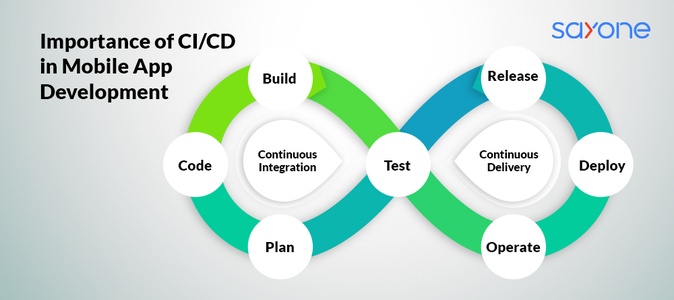Importance of CI/CD in Mobile App Development

Share This Article
Your Complete guide to eCommerce personalization
Table of Contents
Subscribe to Our Blog
We're committed to your privacy. SayOne uses the information you provide to us to contact you about our relevant content, products, and services. check out our privacy policy.
Everyone uses mobile phones now. Whatever the business you are in, whether it is an e-commerce business, a fintech company, or any other business category, mobile apps have become an integral part of businesses. Therefore, developers are compelled to release new features now and then.
Agile methodology has been significantly integrated into mobile app development. This approach helps teams to release features, updates, and software fixes at a much faster rate. Scrums in Agile allow developers to reap the iterative development benefits. In addition to this, developer teams are also using Continuous Integration (CI) and Continuous Delivery (CD) to deliver code and changes in code at higher speeds and more reliably.
Opting for CI/CD can help to exploit the benefits of automated testing tools. In this blog, we attempt to explain why using CI/CD tools helps the release and update of apps at a rapid pace.
What is Continuous Integration?
Continuous integration is a DevOps practice wherein developers push and merge all code changes to a central repository. How does continuous integration work? All the changes are integrated with the existing code base (usually on the staging server) and then tested in a CI/CD pipeline.
Automation testing is integrated into the CI/CD pipeline, as they are triggered automatically to verify the changes in the build phase. There is a learning curve associated with this “frequent integration” practice. However, once developers and testers acquire the CI/CD mindset, the procedures get easier.
Read our blog “5 Best CI/CD Pipeline for Microservices Practices”.
What is Continuous Delivery
Continuous delivery involves the process of delivering the configuration changes, updates, changes, and fixes to the hands of the user at a rapid pace. Production deployment becomes much easier with CD as all the changes would already have been tested in the continuous integration pipelines. This is merely an extension of CI as all the code changes are deployed to the production soon after the build stage. Hence, CD allows for automated releases and one-click deployment.
The main benefits of CI/CD are thus quicker detection of bugs, better product quality, and frequent software releases. In a CI/CD process, the CI/CD pipeline is triggered to test the code that is part of the integration. The pipeline contains instructions in different stages that are designed to build code, run automated tests, and update the test results.
Using CI/CD in Mobile App Development
Currently, millions of mobile apps can be downloaded via the Google PlayStore and the Apple Store. For any app to get noticed and stay ahead, it must be tested in a CI/CD pipeline. Given below are a few pertinent reasons.
1: Realize Timely and Quicker Deployments
CI builds are tested more frequently and developers are alerted in case of bugs in a build. You can include different types of tests like performance tests, UI tests, load tests, etc., to be a part of the automated testing in the CI/CD pipeline.
Only CI/CD can help you with frequent and reliable deployments. Many app development companies also use ‘Beta Testing’ to get user feedback from early app adopters.
CI and CD make it easy to release alternate builds which can be tested continuously and then released. This gives more confidence to the developers to push changes frequently and product owners to confidently chalk out more reliable and frequent releases of the apps.
2: Continuous Testing
If any piece of software goes untested, it might negatively impact the stability of the product. In continuous testing, tests can be triggered in a branch whenever there are code changes to that branch. This can be made possible only with CI.
Download our eBook for FREE: “Global Software Development Rates – an Overview”.
Automated tests can be triggered whenever changes are pushed to a branch or the latest changes are pulled from the repository, etc. Continuous tests would check out and build the code, and run tests together with the new changes.
3: Focusing on Quality
Automated tests are triggered based on events. Performance and load tests that as part of the CI process help in improving the app's reliability and scalability aspects. This allows app developers to completely focus on writing code than worry about the maintenance of the production environment. This allows high-quality code release at a faster pace.
4: Leveraging Benefits of CI/CD Tools
A Few of the different CI/CD tools like CircleCI, Travis CI, Jenkins, Bitrise, and CodeMagic, can be used for continuous testing of mobile apps. Third-party mobile app testing services can help in the testing of different types of mobile apps.
Bitrise and Codemagic are useful in testing native apps, hybrid apps, and web apps. They also allow you to automatically publish apps to Google Play Store, Firebase App Distribution, and App Store Connect.
Conclusion
Together with adding meaningful features to new apps, it is vital to test the apps from the usability, scalability, reliability, and security perspectives. Here, CI and CI can be extremely helpful, as CI/CD tools can help to fast-track the testing and release of the apps. Outsourced mobile testing services companies can help to test mobile apps with popular CI/CD tools.
Looking for web or mobile app development services? Get in touch with us for a free consultation
Share This Article
FAQs
CI/CD is important because it helps all three teams, namely the development, security, and operations teams work with efficiency and effectiveness.
Typically, CI/CD integration into mobile app development helps to save as much as 20% of the time it would have taken otherwise. This helps to cut down development costs.
Subscribe to Our Blog
We're committed to your privacy. SayOne uses the information you provide to us to contact you about our relevant content, products, and services. check out our privacy policy.



